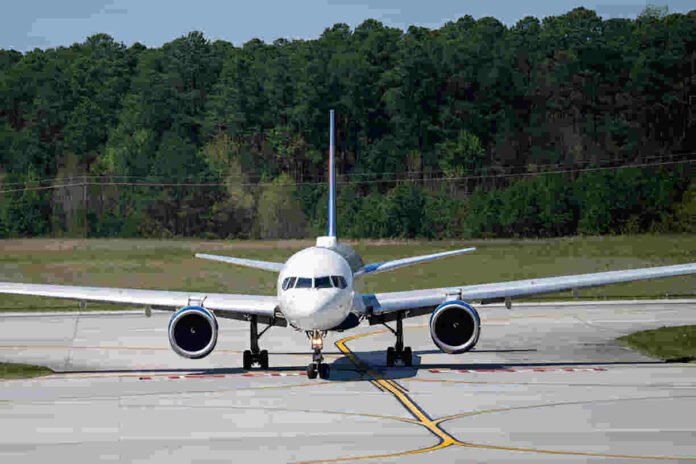Every day, thousands of flights take off around the world, and most of them go entirely unnoticed. They depart, they land, and passengers go about their lives without giving much thought to the mechanics of how smoothly everything ran. But every so often, a flight that was meant to be routine takes an unexpected turn, and suddenly, it becomes the subject of headlines, online discussions, and intense curiosity. That’s exactly what happened with Delta Flight DL275, which diverted to Los Angeles International Airport (LAX), leaving passengers, aviation enthusiasts, and the public wanting to know—what really happened?
For many people, a flight diversion can be nerve-wracking. The idea that a massive aircraft carrying hundreds of people must suddenly land at a different airport sparks both anxiety and fascination. It’s a reminder that while aviation is the safest mode of transportation, it still requires split-second decisions, highly trained crews, and contingency planning to handle the unexpected.
Understanding Flight DL275
The Original Route and Planned Destination
Delta Flight DL275 isn’t just any flight—it’s part of Delta’s long-haul international network, typically connecting major cities across continents. On the day of the incident, the flight was scheduled to travel from its Asian departure city (often Tokyo Haneda or Seoul Incheon, depending on rotation) to the United States. The planned destination was one of Delta’s key U.S. hubs, making this flight strategically important for the airline’s global network.
For passengers, DL275 represents a gateway flight. Some board it as their direct journey home or to their final destination, while others rely on it as a critical leg before connecting onward to other U.S. or international cities. In short, it’s a lifeline for both business and leisure travelers. But what makes DL275 stand out is not just that it diverted—it’s the story behind the diversion, the passenger experiences, and the ripple effects that followed. Why do diversions happen? How does an airline like Delta handle them? And more importantly, what can travelers learn from this situation?
In this detailed blog, we’ll break down the entire journey of Delta Flight DL275, from its intended route to the diversion itself, the impact on travelers, social media reactions, and the broader lessons this event reveals about modern air travel. By the time you finish reading, you’ll not only understand this incident in depth but also feel more informed about what to expect if you ever find yourself on a flight that takes an unexpected detour.
Aircraft Details and Significance of This Route
To operate such a demanding route, Delta typically deploys wide-body aircraft such as the Airbus A350-900 or the Boeing 777-200LR. These planes are marvels of engineering, built to fly over 8,000 miles nonstop, equipped with state-of-the-art avionics, and powered by engines capable of generating enormous thrust.
The A350, for example, carries around 306 passengers, with multiple cabins ranging from Delta One Suites for premium travelers to Main Cabin seating for economy passengers. For an airline like Delta, putting such an aircraft on this route is a clear signal: DL275 is more than a standard flight—it’s a high-value operation connecting two critical markets.
Passenger Load and Operational Importance of the Flight
Flights like DL275 often run close to full capacity, particularly during peak seasons. On this specific flight, hundreds of passengers were on board, representing not just ticket sales but also checked luggage, carry-ons, and even cargo in the underbelly.
The significance goes beyond revenue. Long-haul flights like this play a pivotal role in Delta’s scheduling system. A delay or diversion doesn’t just affect one plane—it can throw off multiple routes, crew schedules, and aircraft rotations for days. That’s why DL275’s diversion to LAX had such a wide-reaching impact.
The Diversion to LAX
What Triggered the Diversion: Weather, Technical, or Medical?
When people hear a plane has diverted, the first question is always: Why? Was it a medical emergency, a mechanical issue, or bad weather? In aviation, diversions generally happen for three main reasons:
Medical Emergencies – A passenger or crew member suddenly becomes ill and requires immediate care at the nearest suitable airport.
Technical Issues – Aircraft systems may show irregularities, and pilots, trained to act cautiously, often divert rather than risk flying on.
Weather Conditions – Severe storms, low visibility, or unsafe landing conditions at the intended destination force a reroute.
In the case of DL275, reports pointed toward operational safety concerns, likely technical in nature. Airlines often describe it as a “precautionary diversion,” meaning the crew identified something that warranted landing sooner rather than later.
Timeline of Events Leading to the Diversion
Let’s break down the sequence of events:
Departure: DL275 departed on time, passengers settled in for what was expected to be a long but smooth journey.
Cruising Altitude: For several hours, everything seemed normal. Food service began, inflight entertainment played, and most travelers relaxed.
Mid-flight Alert: Somewhere along the Pacific route, the flight deck received a signal or alert prompting further checks. While not an outright emergency, the crew determined that continuing to the original destination was not the best option.
Decision to Divert: After consulting with Delta’s operations control and air traffic control, the captain made the call to divert to LAX—one of the most equipped airports in the world for handling large aircraft and unexpected landings.
Smooth Landing: The aircraft descended safely into LAX, where emergency services and ground staff were ready to assist.
How Crew and Airline Handled the Situation Mid-Flight
Passengers later reported how calmly the Delta flight attendants handled the announcement. The captain reassured everyone, explaining that the diversion was a safety precaution and not an emergency. Flight attendants continued service where possible, offered extra reassurance, and ensured everyone was seated for the landing.
Behind the scenes, the Delta Operations and Dispatch team were already coordinating logistics—securing a gate at LAX, arranging maintenance inspections, and preparing to re-accommodate passengers.
Reactions from Passengers on Board
Passenger emotions ranged from uneasy curiosity to relieved gratitude. While some worried about missed connections, others expressed appreciation that Delta prioritized safety. One traveler reportedly posted on social media:
“We diverted to LAX on DL275. Annoying? Yes. But honestly, the crew handled it like pros. I’d rather be late than unsafe.”
Impact on Travelers and Operations
Immediate Consequences for Passengers After Landing in LAX
The moment the plane touched down, passengers were faced with the reality of disrupted schedules. Some had to quickly rebook domestic connections, while international passengers required overnight accommodations before continuing.
Delta staff at LAX stepped in to guide passengers, directing them toward customer service desks where rebooking could be arranged. Families with children, elderly travelers, and those with tight onward plans often received priority assistance.
How Connecting Flights and Schedules Were Affected
For many travelers, missing a connection means more than just waiting—it can mean missed weddings, lost business deals, or rescheduled vacations. DL275’s diversion caused a domino effect, impacting connecting flights at Delta hubs like Minneapolis, Detroit, or Atlanta.
Some passengers were rebooked within hours, while others faced delays stretching into the next day. Those heading to smaller cities with fewer daily flights were most affected.
Delta’s Response and Support for Impacted Travelers
Delta activated its Irregular Operations (IROPs) response team. They offered:
Hotel vouchers for overnight stays.
Meal vouchers for long delays.
Rebooking assistance via app, kiosks, and staff.
Frequent communication to keep passengers updated.
While some travelers praised Delta’s support, others felt the lines at LAX customer service counters were too long, a common challenge during mass diversions.
Broader Implications for Airport and Airline Operations
A wide-body aircraft like the A350 arriving unplanned at LAX requires quick adaptation. Gate assignments must shift, fueling trucks need to be dispatched, and maintenance teams must be available. On top of that, the aircraft’s sudden presence disrupted Delta’s fleet scheduling—delaying the plane’s next assignment until cleared.
Updates on Flight Status Today
Current Status of DL275: Rescheduled, Canceled, or Rerouted
As of the latest updates, DL275’s diverted passengers were successfully rebooked or accommodated. The aircraft underwent inspections at LAX before being cleared for continued service. The flight was not permanently canceled but adjusted for the day’s schedule.
Statements Released by Delta Airlines
Delta issued a formal statement:
“Delta Flight DL275 diverted to Los Angeles International Airport out of an abundance of caution. The safety of our customers and crew is always our top priority. We apologize for the delay and are working to re-accommodate affected passengers.”
Real-Time Tracking and Updates for Passengers and Families
In today’s digital world, families could track DL275 in real time using apps like FlightAware and Delta’s own app. Watching the flight’s reroute offered reassurance once the safe landing was confirmed.
How Long Delays Are Expected to Last
Most passengers were back on their way within 12 to 24 hours. However, some faced longer waits depending on connecting city routes and seat availability.
Passenger Experience and Social Media Reactions
First-Hand Accounts from Travelers on the Flight
Several passengers praised the professionalism of the crew. One said:
“The captain kept us calm the whole time. We knew what was happening and never felt panicked.”
Viral Posts, Tweets, and Videos Shared Online
Hashtags like #DL275 and #DeltaDiversion trended briefly. Photos of the aircraft parked at LAX circulated, alongside lighthearted posts joking about “getting bonus miles in California.”
Public Perception of Delta’s Handling of the Incident
Overall, the public reaction was favorable. While frustrations about missed connections were natural, most observers applauded Delta for prioritizing safety and keeping passengers informed.
Common Themes in Passenger Feedback
Relief at being safe.
Frustration over rebooking delays.
Praise for crew professionalism.
Curiosity about what exactly caused the diversion.
Lessons from the Diversion
Why Diversions Happen More Often Than People Realize
Contrary to popular belief, diversions are not rare. While not everyday occurrences, they happen frequently enough that airlines and crews prepare extensively for them.
Safety Protocols That Protect Passengers During Unexpected Events
Modern aircraft are designed with redundancy systems, meaning even a minor warning can prompt action. Diversions are proof that the system works—the plane identifies issues early and prioritizes safety.
How Airlines Prepare for Emergency Landings
Delta trains its crews to handle diversions with precision. From calm communication to securing emergency services, the entire process is rehearsed repeatedly in simulators.
What Travelers Can Do When Faced with Sudden Diversions
Stay calm—remember, it’s precautionary.
Use airline apps quickly for rebooking before lines get long.
Keep essentials handy like medications, chargers, and snacks.
Contact loved ones early so they know you’re safe.
Looking Ahead: What Happens Next
The Future of DL275’s Scheduled Route
DL275 will continue to be part of Delta’s key long-haul services. The diversion was an isolated incident, not a cancellation of the route itself.
Measures Delta May Take to Prevent Disruptions
Airlines often review incidents like these to improve procedures—whether it’s enhancing monitoring systems, streamlining rebooking, or improving communication channels.
How This Incident Could Influence Airline Policies
Future changes may include better real-time passenger notifications, expanded hotel voucher policies, and even partnerships with local airports to smooth diversion logistics.
Key Takeaways for Frequent Flyers
Diversions are inconvenient but essential for safety.
Always plan buffer time on long journeys.
Trust the crew—they are highly trained for these moments.
Conclusion: The Bigger Picture of Flight Diversions
The diversion of Delta Flight DL275 to LAX may have been inconvenient, but it serves as a powerful reminder of the aviation industry’s commitment to safety above all else. Passengers were delayed, yes, but they were kept safe, informed, and ultimately well-cared for by Delta’s team.
For frequent travelers, the lesson is clear: flight diversions are part of modern air travel. They are not failures but safeguards—proof that the system is designed to protect you. And while no one likes disrupted schedules, arriving late is always better than not arriving at all.
In the end, DL275’s story is less about inconvenience and more about reliability, professionalism, and the extraordinary safety net aviation has built for every passenger who steps onto a plane.

